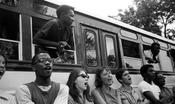text
Multimedia
Ben DeSoto 'Understanding Poverty' exhibit
In this video, photojournalist Ben DeSoto discusses "Understanding Poverty," an exhibit featuring images of people and communities affected by poverty and homelessness.
July 2, 2014


